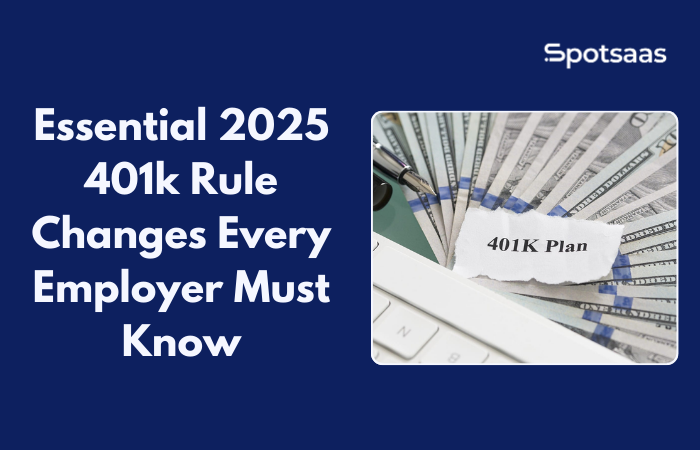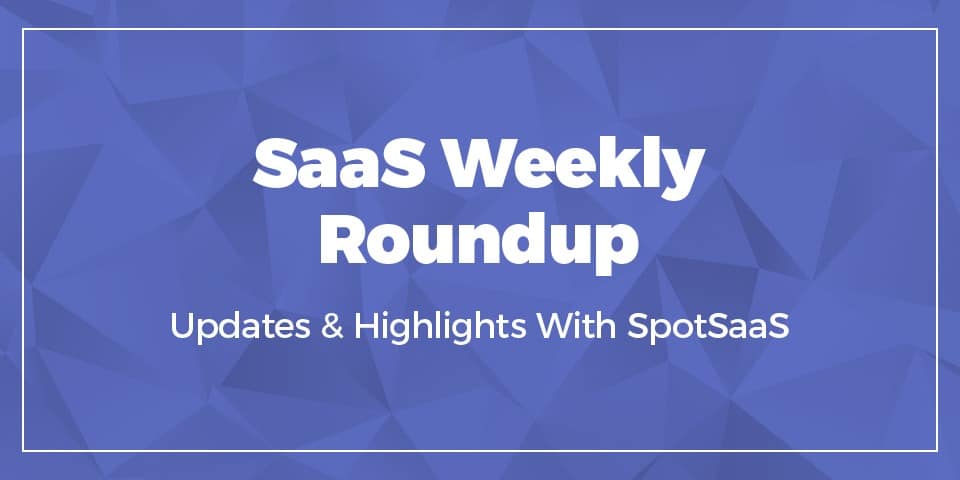The 401k rule changes in 2025 set enormous changes in motion that will decide the future retirement savings for employers and employees. Therefore, it is crucial for employers to stay on top of changes in rules and understand better how best to prepare for them. These changes improve retirement plan accessibility, compliance, and benefits, reshaping how companies manage their 401k plans.
Employers must adapt payroll, benefits, and education strategies to comply with new 401k regulations. Key changes include higher contribution limits, mandatory automatic enrollment, increased small business tax credits, and updated withdrawal rules.
This blog summarizes key 401k rule changes to look for in 2025, their possible impact on businesses, and how employers can prepare to comply. A proactive approach allows businesses to smoothly transition, maximize tax benefits, and assist employees in staying on track toward their retirement income goals.
An Overview of the 2025 401k Rule Changes
Changes to the 401k rules in 2025 are a series of key updates seeking to make retirement savings more accessible and easy to comply with and provide additional tax benefits for employers and employees. Primarily, these changes stem from the SECURE 2.0 Act, which was to enhance retirement security and encourage improved participation in employer-sponsored plans.
Some of the chief modifications are increased contribution limits, widened mandatory automatic enrollment, a higher catch-up contribution for older workers, and new guidelines on emergency withdrawals. Besides, tax credits offered to small businesses that provide 401k plans have been improved, which will make it easier for companies to invest in retirement benefits.
The employer’s additional obligation is compliance with many new Roth 401k rules, new withdrawal procedures, and automatic escalation. These changes have major impacts on payroll processing, plan administration, and employee benefits education. Thus, knowledge of updates will enable businesses to stay within the law and maximize tax benefits while ensuring that their workforce is prepared to face retirement.
Key 401k Rule Changes & Their Impact on Employers
The 401k rule changes in 2025 bring significant updates that impact employer-sponsored retirement plans. With higher contribution limits and new withdrawal policies, employers must update payroll, benefits, and compliance strategies.
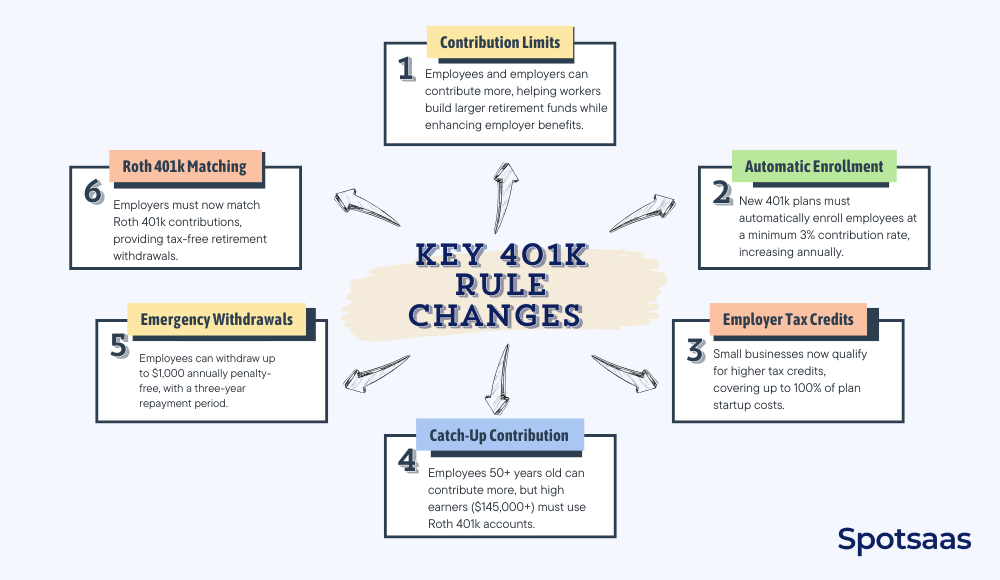
Increased Contribution Limits
In 2025, employee and employer contribution limits will rise, enabling people to save more for retirement. This change enables employees to create a larger retirement fund while allowing companies to provide more competitive benefits.
Employer Impact:
- Update payroll systems to support increased contribution limits.
- Inform employees of new limits and advantages of higher savings.
- Adjust employer matching contributions according to updated limits.
Mandatory Automatic Enrollment Adjustments
According to the SECURE 2.0 Act, employers providing new 401k plans are required to have automatic enrollment for qualified employees, with a minimum default contribution rate of 3%, which rises by 1% each year until it reaches 10%-15%.
Employer Impact:
- Employers are required to comply with automatic enrollment for new plans.
- Reconcile plan documents and payroll deductions to account for mandatory enrollment.
- Give clear employee notices on opt-out and contribution changes.
Increased Employer Tax Credits
To motivate small firms to provide 401k plans, plan startup costs have been increased under tax credits. Firms with fewer than 100 workers are eligible for increased credits, up to 100% of administrative expenses in the first three years.
Impact on Employers:
- Small firms can use tax credits to offset plan expenses.
- Consult with financial advisors to optimize tax savings and compliance.
- Consider establishing a 401k plan to attract and retain talent.
Catch-Up Contribution Changes for Older Employees
Beginning in 2025, employees age 50 and older may make greater catch-up contributions. Moreover, for employees with $145,000 or more in income, catch-up contributions must be contributed to a Roth 401k, as opposed to a regular pre-tax 401k.
Employer Impact:
- Modify payroll systems to permit Roth-only catch-up contributions for high-income individuals.
- Notify employees of expanded contribution opportunities.
- Have plan providers facilitate Roth catch-up contributions.
New Rules for Emergency Withdrawals & Hardship Distributions
Workers can now withdraw up to $1,000 a year penalty-free for emergency needs. Employers should provide at least three years to repay the withdrawn funds before another emergency withdrawal is allowed.
Employer Impact:
- Revise 401k plan policies to include new rules on withdrawals.
- Inform employees about penalty-free emergency withdrawal availability.
- Establish tracking and reporting procedures for withdrawals and repayments.
Roth 401k & Employer-Matching Contribution Changes
Employers with Roth 401k plans need to now accept employer-matching contributions to a Roth account instead of a traditional pre-tax 401k. This gives employees tax-free withdrawals in retirement.
Employer Implication:
- Modify matching contribution policies to accommodate Roth 401k contributions.
- Coordinate with 401k providers to be in compliance with new Roth provisions.
- Inform workers of changes and promote Roth’s involvement.
Final Thoughts
The 2025 401k rule changes update brings increased contribution limits, automatic enrollment requirements, increased tax credits, and updated withdrawal policies. Employers will need to modify payroll systems, revise plan documents, and train employees to achieve compliance and optimize benefits.
Being proactive with these upgrades will assist companies in maximizing retirement benefits, recruiting the best workers, and avoiding non-compliance with changing regulations.
Administrative & Compliance Changes for Employers
The 2025 – 401k rule changes bring about new reporting requirements, regulatory changes, and compliance obligations that need to be met by employers. The changes affect ERISA and IRS regulations, which need to be revised by HR and benefits teams, affecting policies, payroll systems, and plan administration to keep them compliant.
Employers must approach these changes proactively to stay clear of penalties and maintain a smooth transition. If they do not adjust, they could face compliance risks and financial penalties for their companies.
New Filing Requirements & Timelines
Employers must comply with new IRS and Department of Labor (DOL) filing requirements, e.g., revisions to Form 5500 reporting and audit thresholds. Any changes to automatic enrollment policies, contribution plans, or hardship withdrawal rules must be correctly recorded and reported to ensure compliance.
Employers must make sure their record-keeping procedures are brought up to date to take into consideration these changes, eliminating any inconsistencies in audits. Moreover, late or improper filings may lead to fines and administrative costs, and following the rules becomes a top priority.
ERISA & IRS Rule Updates
With more employer responsibilities, businesses need to make sure that their 401k plans meet ERISA fiduciary requirements and SECURE 2.0 provisions. These encompass mandatory automatic enrollment, Roth contribution adjustments, and updated hardship withdrawal rules affecting plan administration.
Employers must examine their plan designs and ensure all employee contributions and withdrawals are processed in accordance with federal regulations. Employers must also educate HR and payroll staff about these changes to prevent mismanagement and ensure flawless implementation.
HR & Benefits Policy Changes
HR and benefits departments must:
- Update plan documents to include new contribution limits, automatic escalation, and withdrawal policies according to the new regulations.
- Modify payroll systems to support Roth catch-up contributions, student loan matching contributions, and other required changes.
- Improve employee communication through detailed guides, webinars, and direct support on opt-out options, tax benefits, and new withdrawal rules.
- Monitor participation trends and opt-out rates, making necessary adjustments to improve employee engagement with the plan.
Final Thoughts
By remaining up to date with these compliance changes, employers can minimize penalties, simplify plan administration, and enable employees to maximize their retirement benefits. Careful planning will mitigate regulatory risks and allow employees to take full advantage of the improved retirement savings options.
Keeping up with these changes will also make companies appear proactive and employee-centric, supporting talent retention and financial health efforts.
Advantages of 401k Rule Changes in 2025
The 2025 401k rule change provides various benefits to employers and employees alike, seeking to enhance retirement savings, tax advantages, and general plan availability. These revisions promote higher participation, financial freedom, and compliance with regulations, ultimately benefiting businesses and workers.
Higher Contribution Levels for Greater Savings
Workers can contribute more to their 401k, resulting in higher retirement savings. Employers can also make matching contribution adjustments, enabling employees to achieve their financial objectives sooner.
Automatic Enrollment Requirement Delivers Larger Participation
The new automatic enrollment requirements provide greater employee participation rates, allowing workers to begin saving early and achieve long-term financial security more easily.
Increased Employer Tax Credits
Small businesses are given larger tax credits to offset 401k plan initiation fees and employer contributions, making it less expensive to provide retirement benefits while lowering overall tax burdens.
Roth 401k Improvements for Tax-Free Accumulation
Workers now have more access to Roth 401k contributions, including company matching. This provision assists employees in making the most of tax-free withdrawals in retirement.
Emergency Withdrawal & Hardship Distribution New Rules
Employees may take up to $1,000 a year penalty-free for emergencies, providing more financial flexibility and less need for 401k loans.
How Employers Prepare for the 2025 Rule Changes
With major 401k rule changes in 2025, employers need to take proactive action to ensure compliance, modify plan designs, and inform employees. By pre-emptively planning, companies can simplify administrative functions and improve employee engagement in retirement savings.
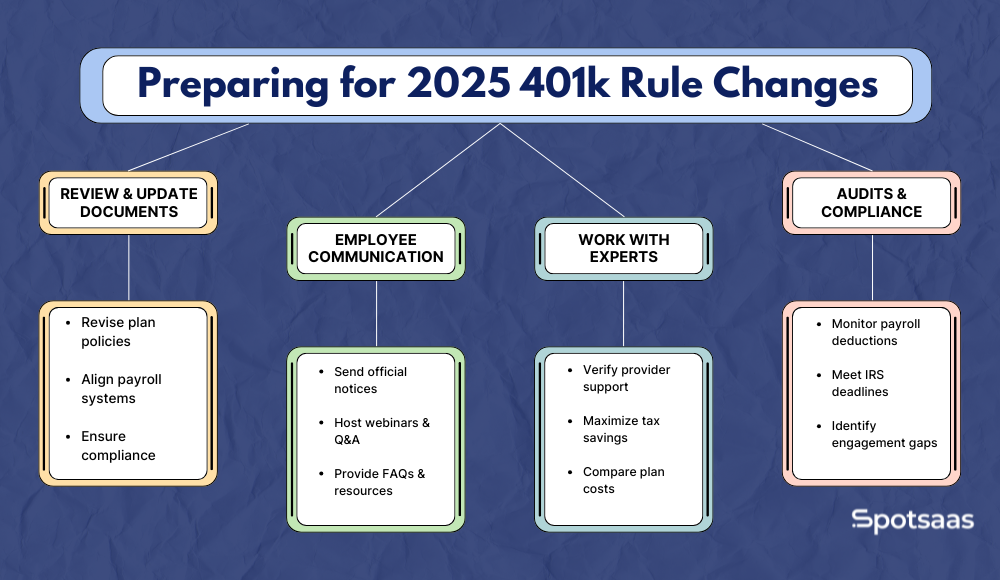
Review & Update Plan Documents
Employers will have to closely collaborate with 401k providers, attorneys, and financial consultants to revise plan policies in accordance with the new contribution limits, automatic enrollment mandates, Roth contribution changes, and withdrawal provisions.
- Revise plan documents to show increased contribution limits and Roth catch-up provisions.
- Make payroll systems consistent with automatic enrollment and escalation mandates.
- Ensure compliance with ERISA and IRS regulations to prevent administrative mistakes and penalties.
Implement Employee Communication Strategies
Awareness among employees is essential to implement 401k rule changes effectively. Employers must clearly communicate plan modifications, contribution possibilities, and withdrawal alterations.
- Distribute official notices that outline new contribution levels, opt-out procedures, and Roth catch-up adjustments.
- Utilize webinars, Q&A sessions, and individual consultations to teach employees how to optimize their retirement savings.
- Offer online resources and FAQ handbooks to make plan information readily available to employees.
Cooperate with 401k Providers & Money Experts
Smooth implementation of the new 401k regulations demands smooth coordination with plan providers and money experts. Employers should:
- Ensure that 401k providers offer Roth catch-up contributions, student loan matching, and automatic escalation updates.
- Collaborate with financial advisors to maximize employer tax savings and plan features.
- Compare provider fees, investment options, and administrative tools to achieve an efficient and cost-effective retirement plan.
Conduct Internal Audits & Compliance Reviews
To stay in compliance, employers need to perform internal audits and monitor participation rates, opt-out trends, and plan effectiveness.
- Periodically monitor payroll deductions, contribution matches, and plan funding levels.
- Ensure IRS and ERISA reporting requirements are fulfilled prior to deadlines to prevent fines.
- Determine gaps in employee engagement and correct them with targeted education programs.
Final Thoughts
By following these steps, employers will successfully manage the 2025 401k rule change modifications, stay compliant, and assist employees in getting the best from their retirement savings. Being proactive will not only make administrative tasks easier but also increase employee satisfaction and long-term financial security.
How to Prepare for the 2025 401k Rule Changes: Step-by-Step Guide
The new 401k rule changes in 2025 necessitate employers to take proactive measures to remain compliant, restructure plans, and inform employees. An informed approach will enable companies to meet regulations while maximizing employee enrollment in retirement plans.
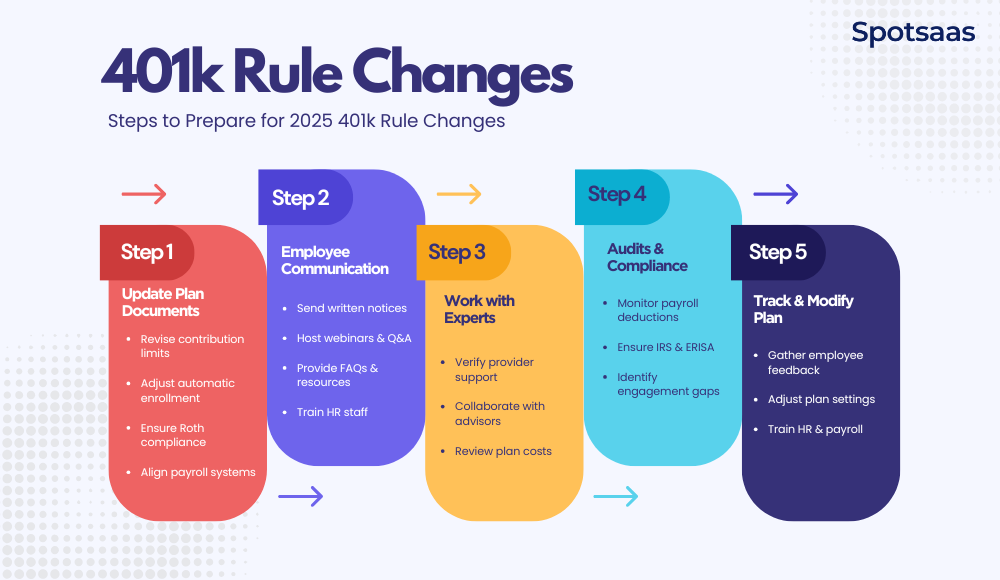
Step 1: Review & Update Plan Documents
Employers need to collaborate closely with 401k providers, legal specialists, and financial consultants to ensure that their plan documents incorporate the current IRS and ERISA rules. The major areas to revise are:
- Contribution limits to cover the new maximums.
- Automatic enrollment and escalation provisions to adjust to mandatory participation policies.
- Roth catch-up contributions and withdrawal rules to correct recent legislation.
- Payroll and HR systems to facilitate adjustments and proper deductions.
Step 2: Implement Employee Communication Strategies
Open communication is vital for employees to comprehend how the changes affect their retirement savings. Employers should:
- Offer written notices of new contribution limits, opt-out procedures, and withdrawal rules.
- Hold educational sessions, webinars, and Q&A meetings to clarify major changes.
- Provide employee guides, FAQs, and website resources for employees to be able to self-navigate through changes to their 401k plans.
- Make sure that HR staff are well-aware and prepared to answer employee inquiries.
Step 3: Working with 401k Providers & Financial Advisors
Employers should work with 401k plan administrators, payroll vendors, and financial advisors to make sure that the changeover is effective. This encompasses:
- Confirming that 401k providers offer Roth catch-up contributions, employer match adjustments, and automatic escalation features.
- Collaborating with financial advisors to maximize tax advantages and optimize plan offerings.
- Examining provider fees, investment choices, and administrative tools to ensure cost-effectiveness and efficiency.
Step 4: Conduct Internal Audits & Compliance Reviews
Regular audits enable employers to monitor participation rates, evaluate opt-out patterns, and confirm compliance with reporting. Some of the most important actions are:
- Verify payroll deductions and contribution matches and plan funding levels for accuracy.
- Confirming IRS and ERISA compliance by adhering to reporting deadlines and filing necessary documentation.
- Discovering gaps in employee engagement and closing them through focused education efforts.
Step 5: Track & Modify the Plan According to Employee Needs
Employers should continuously monitor the success of the plan and make changes according to employee involvement and input. This includes:
- Obtaining employee feedback regarding default contribution levels, investment options, and savings plans.
- Modifying plan attributes, such as automatic escalation levels and opt-out provisions, to promote long-term saving.
- Providing ongoing training for HR and payroll teams to ensure smooth administration and compliance with evolving regulations.
Conclusion
The 2025 401k rule changes are challenging and beneficial to employers alike. By remaining abreast of current information and continuously updating plan documents, payroll systems, and compliance plans, companies can ease the transition with minimal disruption and maximize the advantage for employees.
Financial literacy and open communication will be crucial to assisting workers with new contribution thresholds, automatic enrollment modifications, and withdrawal options. Collaborating with 401k providers, financial planners, and legal professionals will also assist employers in making these transitions more effective.
With these actions, companies can improve retirement security, increase employee satisfaction, and ensure full regulatory compliance through 2025 and beyond.
Frequently Asked Questions
What are the key 401k rule changes in 2025?
The 2025 updates include higher contribution limits, mandatory automatic enrollment for new plans, Roth catch-up contribution requirements for high earners, expanded employer tax credits, and new rules for penalty-free emergency withdrawals.
How do the new automatic enrollment rules affect employers?
Employers offering new 401k plans must automatically enroll eligible employees with a default contribution rate starting at 3%–10%, increasing annually. Employers need to update plan documents and payroll systems to comply.
What are the new catch-up contribution requirements?
Employees aged 50 and older earning $145,000 or more must make catch-up contributions to a Roth 401k instead of a traditional pre-tax account. Employers must adjust payroll deductions and plan structures to accommodate this change.
Are there new employer tax credits available?
Small businesses may qualify for higher tax credits covering up to 100% of plan startup costs for the first three years. Additional tax benefits apply for employer-matching contributions.
How should employers prepare for these changes?
Employers should review and update plan documents, educate employees, collaborate with 401k providers and financial advisors, conduct compliance audits, and adjust payroll systems to align with the new regulations.


